Are you a Quiet Speculation member?
If not, now is a perfect time to join up! Our powerful tools, breaking-news analysis, and exclusive Discord channel will make sure you stay up to date and ahead of the curve.
Welcome back. readers!
Today's article is inspired by some comments in Sigmund's article this week. Sigmund remarked how Red Deck Wins decks always seem to win the first couple of major events of a new format and then usually peter out to Tier 2. Sure sometimes we have someone like Tom Ross just break the format wide open with a hyper aggressive red deck, but usually that's the result of a metagame that has shifted away to more control and midrange strategies which focus on beating each other and sacrifice their early game defenses.
The point is that the hyper-aggro decks (usually with red in them) usually win at the start of the format because all the synergies/strategies are still amorphous and the MTGO hive mind hasn't had a chance to operate with all the new mechanics (and/or recover from the loss of all the old ones). In this environment it obviously pays to play a fast linear strategy to punish everyone who is still figuring things out.
What this means to us MTG speculators and financiers is that we have a predictable pattern that usually causes one (or more) cards to jump up in value in a short amount of time. To make it even easier this card is usually red (or has red in it) because red is the MTG color of aggression. In order to pick out our winners we should review some past winners.
Stromkirk Noble
Innistrad block (Zendikar rotation)
As you can see by the graph, this card jumped quickly and for a brief time was over 15 dollars. Care to guess what occurred on that weekend? I'll give you a hint it rhymes with Crates. Stromkirk pre-ordered on many sites for a dollar (I had a friend who only pre-ordered four cards...all of them were Stromkirk Nobles).
The important characteristics of Stromkirk Noble are:
- Red
- 1-drop
- Aggressive creature (that happens to get bigger as the game goes on)
- Has somewhat relevant evasion in a format where many of the low drops were humans.
Falkenrath Aristocrat
Innistrad Block (Scars block rotation)
Falkenrath Aristocrat is actually more expensive (CMC-wise) than we typically see, but with the rotation of Scars of Mirrodin and an influx of new red-black cards (courtesy of the Rakdos guild) a hyper aggressive deck jumped to the top of the metagame. The fact that this card came from a less popular 2nd set and was an under-appreciated mythic made its ascension rapid and impressive.
The important characteristics of Falkenrath Aristocrat are:
- Red
- Haste
- Evasion
- Self-protection
Thundermaw Hellkite
M13 (Scars block rotation)
Thundermaw saw its heyday similar to Falkenrath Aristocrat. It was the desired "high-end finisher" for the aggressive decks--granted these decks sacrificed some speed for a bit more play late game. Similar to Falkenrath it was a mythic from a less opened set, however, it was a dragon and pre-ordered rather high. The fact that there was only a three-month gap between M13 and the release of RTR also meant that it never really had time to drop a whole lot as the price memory from pre-order kept a lot of people from unloading it quickly.
The important characteristics of Thundermaw Hellkite are:
- Red
- Haste
- Evasion
- Power in line with its CMC (i.e. 5-power creature for five mana, which while not spectacular, when paired with its other abilities made it a very solid deal in the mana department).
- Its ETB effect was very good against Lingering Souls and Restoration Angel which were powerful and popular cards at the time and were some of the few roadblocks that might actually keep most other haste creatures from getting in for damage.
Ash Zealot
Return to Ravnica (Scars of Mirrodin rotation)
Ash Zealot didn't see quite the impressive jumps that our previous three choices saw, but part of the reason was that by now people had started to really notice this trend and stores were weary of pre-ordering any cheap/efficient/red creatures at anywhere near bulk prices.
The important characteristics of Ash Zealot are:
- Red
- Haste
- Power in line with its CMC (2 for 2)
- First Strike
- Its static ability was actually very relevant given Innistrad block brought back flashback as a mechanic.
Hellrider
Dark Ascension (Scars Block rotation)
Hellrider lived a pretty quiet life while his block was being opened en masse and it wasn't until Scars of Mirrodin rotated out of Standard and the first wave of hyper-aggressive red decks hit that he really found a good home. It again helped that he was printed in the 2nd small set of the block that didn't have a lot of interest behind it.
The important characteristics of Hellrider are:
- Red
- Haste
- An ability that plays exceptionally well with a lot of smaller 1- and 2-drop creatures.
Boros Reckoner
Gatecrash (no rotation)
Boros Reckoner is the first one on our list that occurred without a rotation. A lot of people just compared him with Spitemare and assumed he would see about as much play as that card did.
They failed to recognize two things. He had the ability to give himself first strike and while his CMC was more demanding he fit very well on curve. Mana was really good courtesy of both shock lands and check lands so he wasn't that hard to cast on turn three. It also helped that he comboed with Blasphemous Act to wipe the board and deal 13 damage to your opponent.
The important characteristics of Boros Reckoner are:
- Red
- Power in line with its CMC (3 for 3)
- First Strike
- A very relevant ability as he was often nigh unblockable by large creatures since their owners would take even more damage than just letting him through.
Legion Loyalist
Gatecrash (Innistrad rotation)
Legion Loyalist was a card that started out around $4 dollars (as again people had caught on to this trend), occasionally popped up in a deck during RTR block draft days, but slowly dropped in value. With Innistrad block rotating out there was once again a "best deck" vacuum and cheap, hasty red creatures jumped up in demand.
The important characteristics of Legion Loyalist are:
- Red
- 1-Drop
- Haste
- An ability that granted first strike to all your attackers and a slight form of evasion.
Stormbreath Dragon
Theros (Innistrad rotation)
Stormbreath started decently high, dropped a bit during pre-orders and then proved himself the real deal when Theros hit. I remember lots of people asking me if I had any for trade the first few weeks and I unloaded the one I did have (a Japanese one) for $45 in trade.
The important characteristics of Stormbreath Dragon are:
- Red
- Haste
- Evasion
- Protection from a color with a lot of removal
- The ability to get bigger and deal damage in the process
And now with the release of Khans of Tarkir our RDW champion is...
Mantis Rider
Khans of Tarkir (Return to Ravnica rotation)
Mantis Rider is our next in the line of hasty red flyers with power equal to its CMC, however, this card is the first on our list that is tri-colored. Normally the concerns about tri-color cards are that it pigeonholes the deck's color options and makes it difficult to cast on curve. Both of these concerns are relevant, though we do have a lot of solid mana fixing in Standard at the moment. I personally feel like this is one to unload as being forced into all three specific colors just to play it really does limit one's options.
The important characteristics of Mantis Rider are:
- Red
- Haste
- Evasion
- Power on curve with its CMC
Summing it Up
You likely noticed that this style of card is almost always red (in this list it always was, but there are sometimes exceptions). Haste is often a keyword, in the early game acting like a burn spell and then continuing to cause damage until the opponent answers it.
Some form of evasion is also pretty typical, whether it be flying (most common), protection from a color, or even limiting what types of creature can block it. You'll also notice that its power-to-CMC ratio is almost always at least 1:1, so for every mana in the cost we expect to see the power up by at least one, and more often than not you might see some other ability tacked on. All these characteristics point to the next "RDW All-Star" (at least for a few weeks).


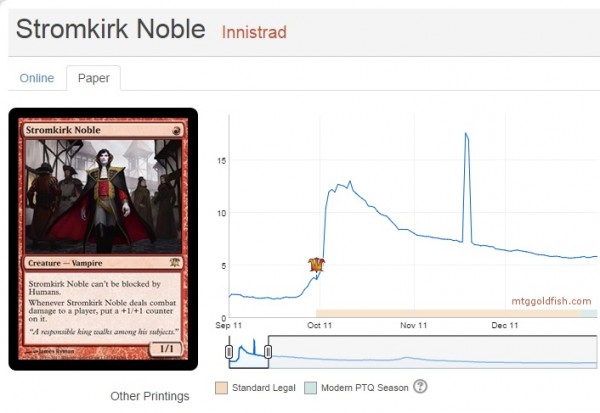
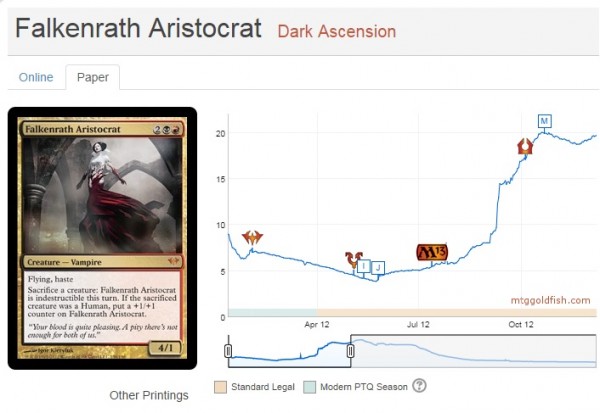
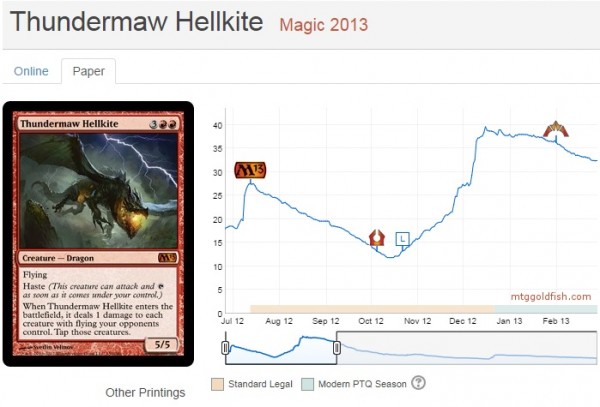
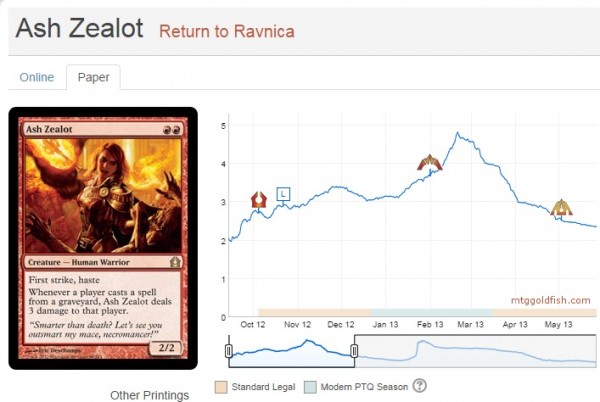

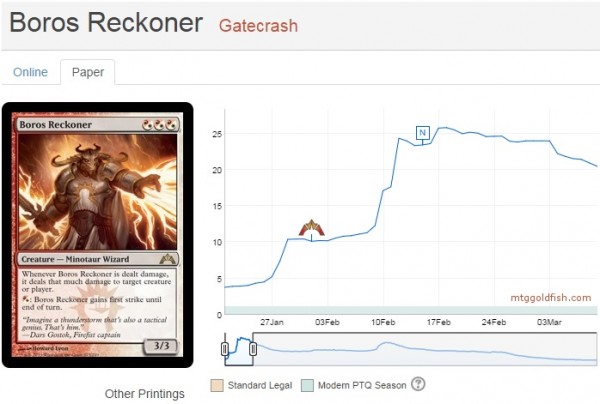
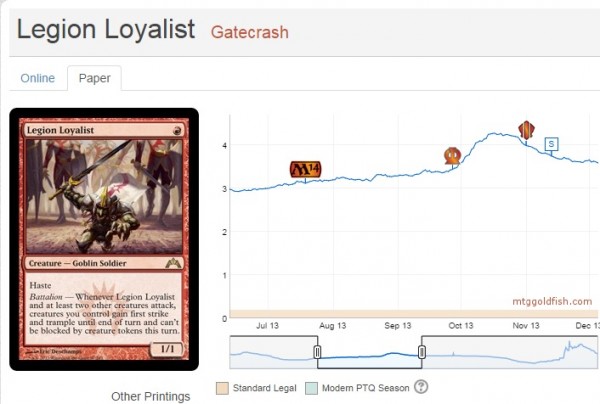
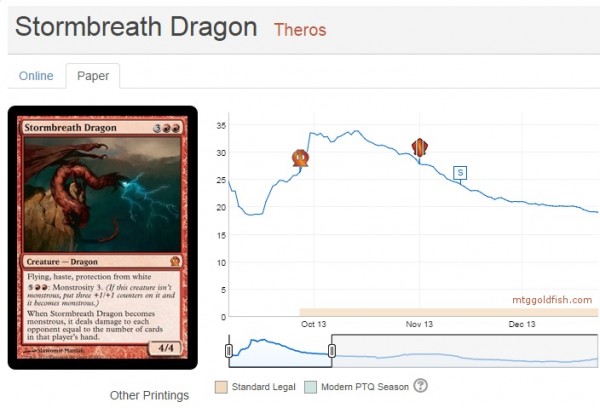
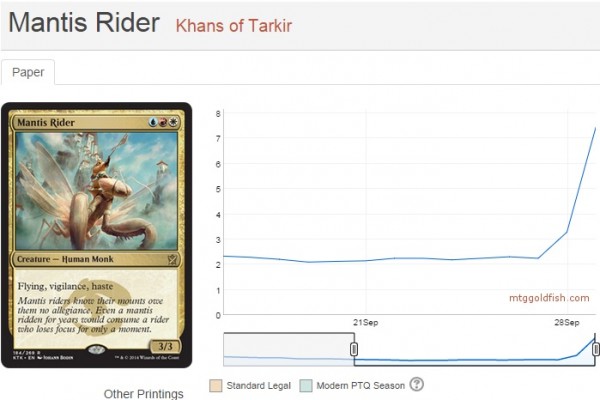


The sentence (Ash Zealot) “but part of the reason was that by now people had started to really notice this trend ” makes this article…
Well, I don’t know, maybe i haven’t read it well enough, but I seem to be missing what I have to do with this information. What are the cards you have your eye on ?
Because if people notice the trend, will it still be there then ?
Well if you look at the price graphs there are still plenty of oppurtunities (look at Mantis Rider). What I wanted to convey was that you’re less likely to see these RDW all-stars starting at the very bottom. Instead, dealers are starting them out above bulk (see Mantis Rider @ 2.50), but they often have plenty of room to grow. The point of the article was to highlight the characteristics that make up these RDW All-Stars so that you (as a speculator) can see what makes up these types of cards and not just jump on every cheap red creature. After all, for every Stromkirk there are plenty of Exava’s.
Thanks for the shout-out and for taking down this style article. To build, I’d love to see a look back even further than just the last year or two. Did Goblin Guide spike when the previous block rotated out of Standard? What about Vexing Devil? There’s so much more to be explored in this space, but you did a nice job scratching the surface.
What’s your key conclusion from all this? You summarized WHAT you look for in a good red aggro card, but I’d love to hear your thoughts on when (if) we should buy into these cards and, perhaps more importantly, when to sell.
I did review Vexing Devil, but it did NOT spike until it rotated out of standard. They pre-ordered for 7.50 (I know because I bought 8…and so did my friend Eric). I really wanted to include Goblin Guide as well, however, I tried multiple sites and couldn’t get solid data from back then (so many of these sites occured after Zendikar block) that I was limited in which ones I could use.
Regarding Boros Reckoner, I think you failed to mention that he matched up favorably against Thragtusk, which was all over the place at the time.
Vexing Devil didn’t see much Standard play, it’s price was mainly propped up by casual players, and then later, Modern Burn.
Sarkhan, Chandra’s Phoenix, and Goblin Rabblemaster should be on this list as well.
As far as targets for this Standard go, Stormbreath should be #1 (it’s finally started going back up). If you want a low risk target, Firedrinker Satyr is still dirt cheap, though I don’t expect aggro to do all that well until we start seeing less midrange and more control.